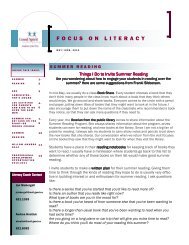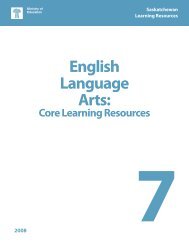Converting Fractions into Decimals - GSSD Blogs
Converting Fractions into Decimals - GSSD Blogs
Converting Fractions into Decimals - GSSD Blogs
You also want an ePaper? Increase the reach of your titles
YUMPU automatically turns print PDFs into web optimized ePapers that Google loves.
Amy Satterfield<br />
<strong>Converting</strong> <strong>Fractions</strong> to <strong>Decimals</strong> Using Base Ten Blocks – Grade 5<br />
.<br />
Learning Objective<br />
Students will convert fractions <strong>into</strong> decimals by dividing the numerator by the denominator with<br />
the use of base ten blocks.<br />
Common Core Standards<br />
Standards for Mathematical Content<br />
CCSS.Math.Content.5.NF.B.3 Interpret<br />
a fraction as division of the numerator<br />
by the denominator (a/b = a ÷ b)<br />
ex. by using visual fraction models or<br />
equations to represent the problem.<br />
Prior Knowledge<br />
Standards for Mathematical Practice<br />
• Make sense of problems and<br />
persevere in solving them.<br />
• Construct viable arguments and<br />
critique the reasoning of others.<br />
• Model with mathematics.<br />
• Use appropriate tools strategically.<br />
• Attend to precision.<br />
Materials<br />
• Definitions of the terms numerator<br />
and denominator<br />
• Decimal place value<br />
• Division<br />
• Base ten blocks for each pair of<br />
students<br />
• Smartboard with virtual base ten<br />
blocks<br />
• Assessment question page<br />
Procedure<br />
Pre-assessment: Have students share what they know about fractions and decimals orally, as a<br />
class.<br />
Introduction: Explain to students that we can represent numbers several different ways. We can<br />
represent the same amount as either a decimal or a fraction. Today we are going to be<br />
working on converting fractions <strong>into</strong> decimals.<br />
Modeling: “Let’s start with a fraction many of you might already know the decimal equivalent<br />
of. Your friend is coming over after school. There is only one cookie left, so you decide to<br />
share the cookie equally. This hundreds block represents the one cookie. We need to divide<br />
the hundreds block equally in half. To do that, I am going to exchange my hundreds block<br />
for 10 ten rods. Each ten rod represents one-tenth. Now I need to divide these equally <strong>into</strong><br />
two groups. When I have divided the pieces equally, I have five ten rods in each group,<br />
which is five-tenths.” (Use the Smartboard to show exchanging the hundreds block for 10<br />
ten rods. Then separate the ten rods equally, one at a time, ending with five in each group.<br />
Write 0.5 on the Smartboard.)
Guided Practice: Next, the students and I will work on solving problems together. The students<br />
will be working in partners and using the base ten blocks.<br />
Problem: You are making a project in art class. There are two pieces of paper, but five<br />
students need to use a part of the paper. You need to share the papers equally. What decimal<br />
represents how much of the paper each student gets?<br />
Show two hundreds blocks on the Smartboard. Trade those hundreds blocks in for 20 ten<br />
rods. Have students work with their partner to separate the ten rods <strong>into</strong> five groups. Walk<br />
around to check students’ work and assist when necessary. After giving students a chance to<br />
figure it out for themselves, work the problem out on the board using the base ten blocks.<br />
Then, record the answer as 0.20 on the Smartboard.<br />
Next problem: You decided to invite three friends over this weekend, so there are four of<br />
you total. You only have one large bottle of soda to share. What decimal represents how<br />
much of the bottle of soda you each get?<br />
Show one hundreds block to represent the one bottle of soda. Trade that hundreds block in<br />
for 10 ten rods. Have students work with their partner to separate the ten rods <strong>into</strong> four<br />
groups. Walk around to check students’ work and assist when necessary. After separating<br />
the ten rods equally, 2 ten rods should be left over. Ask students how many ten rods are in<br />
each group. Record 0.2 on the Smartboard.<br />
Explain to students that we have 2 ten rods leftover. We need to exchange those for 20 ones<br />
cubes so that we can divide them equally. Have students divide the ones cubes equally<br />
among the four groups. Walk around to check students’ work and assist when necessary.<br />
Ask students how many ones cubes you added to each group. These represent hundredths.<br />
Add 0.05 to the answer of 0.2 on the Smartboard to make a total of 0.25<br />
Independent Practice: Students will independently solve this problem using base ten blocks:<br />
Your family ordered one large pizza, and there are five people in your family. What decimal<br />
represents how much of the pizza each person gets? Draw a picture of how you divided your<br />
base ten blocks.<br />
Assessment<br />
Next Steps<br />
• Informal observation during<br />
guided practice portion of<br />
lesson<br />
• Check independent practice<br />
question for correct answer<br />
and ability to prove answer<br />
with a drawing<br />
• Convert fractions to decimals<br />
using hundreds grids<br />
• Convert fractions to decimals<br />
using standard long division<br />
algorithm<br />
• Review/Practice with iPad app:<br />
Math Tappers - Equivalents
















